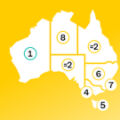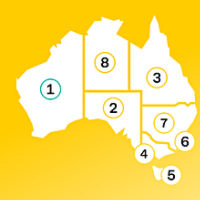“Overall, the economic performance of Australia’s states and territories is being supported by a strong job market, robust government spending and solid population growth at a time of higher cost-of-living pressures.
“Economic growth has slowed however, as consumer spending remains subdued due to still-elevated borrowing costs. As we look ahead, an expected reduction in interest rates could boost economic sentiment in the mortgage-sensitive states of New South Wales and Victoria, while the interplay between interest rate cuts, federal election outcomes, and global trade dynamics will be crucial in shaping the economic outlook."
In the April 2025 edition of the State of the States:
Western Australia ranked first on five economic indicators: retail spending, relative unemployment, relative population growth, housing finance and dwelling starts.
Victoria moved up from fourth to second place, leading on construction work done and ranking second on retail spending and third on relative population growth. The state however finished bottom of the table on relative unemployment.
Queensland slipped one spot to third place, performing well across the housing finance, dwelling starts and retail spending indicators, despite weak equipment investment.
South Australia dropped from equal second to fourth position on the leaderboard, ranking second on three indicators but held-back by lower rankings on economic growth, equipment investment and relative population growth.
Tasmania is steady in joint fifth spot — leading on equipment spending. NSW moves up to equal fifth from sixth position and now ranks first on economic growth, while the ACT remains seventh — in that position on three indicators.
The Northern Territory stays in eighth place, however the decade-average method of assessing economic performance disadvantages the Top End given significant LNG construction over 2012–18 inflated a range of economic indicators.
Annual growth rates
The State of the States report also compares the annual growth rates across the eight major indicators, enabling comparisons in terms of economic momentum. This quarter’s report revealed:
- The commodities and tourism-heavy state of Western Australia continues to outperform the rest of the nation, also ranking first on five of the eight key economic indicators.
- Queensland slips from first to second place but is ranked second or third on four of the major economic indicators. The housing market remains a pillar of support for the Sunshine State economy amid still-strong interstate migration.
- Victoria shot up to third spot, benefitting from solid retail spending, construction activity and inbound overseas migration.
- There is little separating Victoria from South Australia (fourth), Northern Territory (fifth) and NSW (sixth).
- Tasmania (seventh) and the ACT (eighth) are both being held back by slowing population growth and retail spending.
About the CommSec State of the States Report
The April 2025 edition of the State of the States report uses the most recent economic data available. While population growth data relates to the September quarter of 2024, other data – such as unemployment – is much timelier, covering the month of March 2025, with the majority of the other indicators using December quarter of 2024 figures.
CommSec, the self-directed broking arm of Australia’s largest bank, assesses the performance of each state and territory on a quarterly basis using eight key indicators. Those indicators include economic growth, retail spending, equipment investment, unemployment, construction work done, population growth, housing finance and dwelling commencements.
Just as the Reserve Bank of Australia (RBA) uses long-term averages to determine the level of "normal" interest rates, CommSec compares the key indicators to decade averages; that is, against "normal" performance.
CommSec also compares annual growth rates for eight key indicators for all states and territories, in addition to Australia as a whole, enabling a comparison of economic momentum.



